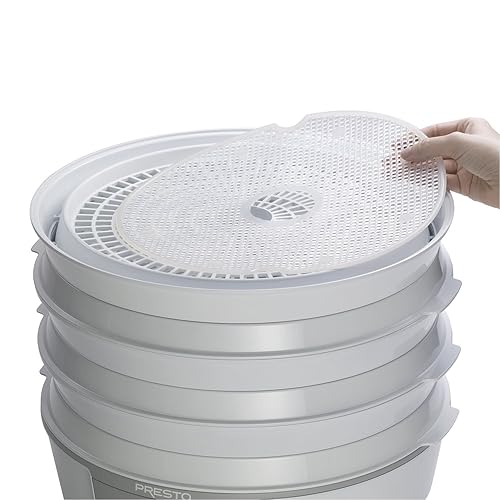Stainless steel vs Plastic food Dehydrators
In this modern world, time is precious and its money. Thus, the reality is that people don’t have enough time to make tasty and healthy dishes for their families while balancing everything else they’ve got going on in their lives. So, how do you ensure that you’re eating healthy, all the while investing the least amount of time possible while prepping? Well, the answer lies in the age-old technique of food preservation—dehydration (think beef jerky, crunchy snacks, and fruit leather). Food dehydration is a time-efficient process that’s simple and results in you not just eating healthy but also saving time.
Recognizing the plethora of benefits users get from food dehydration, kitchen appliance companies launched a variety of different food dehydrator models. Food dehydrators are absolutely great! In fact, they may just be one of the best investments for your kitchen. How do they work? Dehydrators remove the moisture in the food material using hot air. No matter which dehydrator you select, its design, price, quality, that is the primary principle on which it runs. The fan and heating element can be mounted in the top, bottom, or back of the unit. These appliances are designed to help you to enjoy the summer fruits in the dead winter, all the while staying away from the preservatives and additives that grace store-bought products.
You can enjoy the chips and snacks without getting high calories. You can also make crunchy snacks from soft and pulpy bananas by using this appliance. It has many benefits. To boot, these appliances are available in a wide variety, with a wide range of prices to accommodate different types of users. But before you take the leap and purchase a dehydrator for your kitchen, you have to check its features and quality to ensure that it’s the right match for you. We know the process of selection can be confusing and tiring, but we’re here to help you through it.
Now, the first thing you need to know is that there are two types of dehydrators that are available in the market—those made with plastic and those made with stainless steel. What’s the difference between the two? Well, that’s what we’re here to detail out for you. Keep reading, because we share everything you need to know about these two types of dehydrators to make the right choice.
Plastic Dehydrators
Plastic is present all around us and makes an appearance in many kitchen appliances, so really it shouldn’t come as a surprise that the most commonly used material for dehydrators is plastic. These dehydrators are the most reasonable and affordable. They are much cheaper than the stainless steel counterparts, so if you are on a limited budget then buying a plastic dehydrator may be the best choice for you. Of course, when talking about these plastic dehydrators you don’t have to worry about health & safety concerns. Most plastic dehydrators today are made with high quality plastic that’s BPA-free. Nonetheless, you should ensure that the model you select is BPA-free to avoid any concerns about unwanted chemicals leeching into your food and causing any illnesses.
You will also be glad to learn that plastic dehydrators are easy to wash, they mostly just require warm soapy water for cleaning. They are also designed to be easy to handle. The Nesco Snackmaster Express is one of the most common and efficient appliance on the market. In addition to that, you should also consider other food dehydrator models by Nesco and Presto. These companies make plastic dehydrators that easy to use and easy to clean, all the while boasting of an affordable price tag.
The downsides however, you’ll want to keep in mind too. These dehydrators stain easily in comparison to those made with stainless steel. Sometimes the trays of plastic dehydrators lose their shape due to high temperature or if they’re poor quality, even get melted. Depending upon the model and machine you select, these dehydrators can also be noisy. Definitely not a boon if you plan on using these at night.
Stainless steel Dehydrators
Stainless steel is the other material which is used most commonly in the market. It is considered as professional and it is more expensive than plastic needless to say. However, the increased price tag also translates into advantages. These dehydrators are durable, long-lasting, and can withstand high temperature for a long period of time than the plastic counterparts. The trays of the dehydrator remain in their shape even after long exposure to heat. Of course, sometimes the dehydrators exterior may be made with stainless steel while the trays are plastic. So, you’ll want to properly read about the machine before you commit to it.
Sleek and clean, they have great looks and more often than not can actually amp up the modern looks of your kitchen. They are very easy to clean and wash and are usually dishwasher safe, unlike the cheap plastic competitors. They are less noisy than plastic dehydrators too! Not just that, they are also more efficient. They can sustain drastically high temperature without any risk of damage because they are made of stainless steel.
There is one drawback of stainless steel food dehydrators however that you’ll want to take note of—calcium may deposit on it and it is quite visible on paler appliances.
Many well known stainless steel food dehydrators are available in the market. You can buy any one of them according to your requirement.
Final Verdict
Overall, this comparison between stainless steel and plastic helps you to decide whether the plastic or stainless steel dehydrator is the best fit for you, because both have their own set of advantages and disadvantages. Typically novices prefer to opt for plastic while professionals stick with the more commercial-use stainless steel option.

